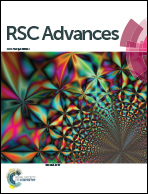A cubic room temperature polymorph of thermoelectric TAGS-85†
Abstract
The alloy (GeTe)85(AgSbTe2)15, commonly known as TAGS-85, is one of the best performing p-type thermoelectric materials in the temperature range 200–500 °C. In all reports thus far, TAGS-85 adopts a rhombohedral crystal structure at room temperature and undergoes a reversible transition to a cubic phase in the middle of the operating temperature range. Here, we report on a novel, metrically cubic polymorph of TAGS-85 that can be obtained at room temperature using a particular cooling protocol during initial synthesis. This polymorph transforms irreversibly on initial heating to a 21-layer trigonal structure containing ordered cation vacancy layers, driven by the spontaneous precipitation of argyrodite-type Ag8GeTe6. We show that the precipitation of Ag8GeTe6 is detrimental to the thermoelectric performance of TAGS-85 due to an increase in the vacancy concentration, which makes the samples more metallic in character and significantly reduces the Seebeck coefficient. The precipitation of Ag8GeTe6 can be suppressed by careful control of the synthesis conditions.



 Please wait while we load your content...
Please wait while we load your content...